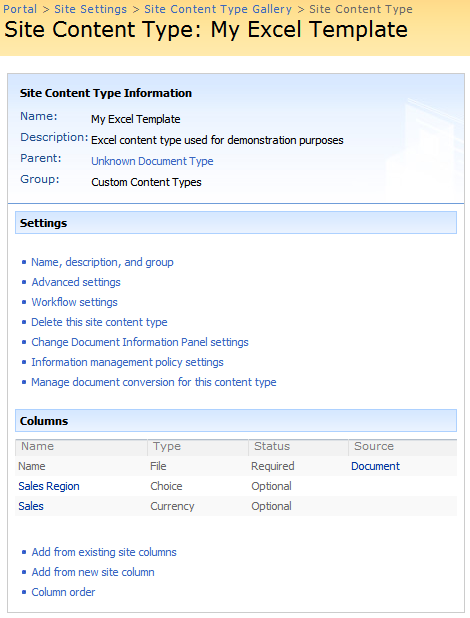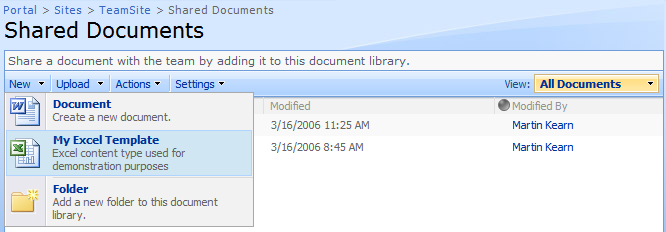For one of our clients we need to build custom site definitions. When building SharePoint solutions the terms site template, definition and to a lesser extent site portal are often used. Each of these allows the user to create a new site with a predefined set of Content Types, Layouts, and Lists etc. In the case of the Portal, it allows the user to create a site and one or more nested child sites.
Site definitions are our preferred way to develop custom sites. A portal definition is a variation of the Site Definition except that the definition describes a series of sites to be created. An example of this is the Site Collection Publishing Template, which creates a root site collection, a News sub site, a Documents sub site and some others.
The focus of this article is on how site definitions and Portal definitions can be created and deployed. Site definitions are usually deployed as a part of a solution package, which is a compressed cabinet file made up of XML files and other resources. Solution packages are first added and then deployed to the MOSS farm. Once deployed the contents of the solution can be made available to sites, or used to create new sites.
The Solution Package can also deploy Site Features. A Site Feature can do myriad things, such as deploying a new web part, defining a new content type, site column, list type, adding a new page layout, or even a graphic image. Site Features can then be activated in a site, or automatically applied in a new site definition. We typically deploy several features as part of the new site definition, as this allows multiple developers to work together without interfering with one another. The solution and feature methodology is a powerful new model for MOSS and is used by Microsoft to build and extend MOSS.
CREATING A SITE DEFINITIONTo create a site definition the first step is to create the “WebTemp” file. The purpose of the webtemp file is to describe to SharePoint the new Site Definition or Site Portal Definition. After the WebTemp file, the Site Definition file should be created, this is known as the ONET.XML file. Each Site Definition contains one or more configurations of lists and features. A site Definition can also point to a Portal Definition. The portal definition uses one or more site definitions. The relationship of files is shown below:
WEBTEMP FILE
All the webtemp files are XML files which live in the <12-hive>\TEMPLATES\1033\XML. The webtemp file can be thought of as Meta data or a description of a Site Definition. For example, the file contains the name of the site definition, as displayed in the Create Site page in a site or the Create Site Collection page in Central Administration.
Each Site Definition description is in a <Template> node that contains one or more configuration nodes. The name assigned to a Template must match the name of a directory in the <12-hive>\TEMPLATE\SiteTemplates directory. SharePoint then looks for the ONET.XML file in a subdirectory called XML to find the actual Site Definition. The ID of the Template must be unique across the SharePoint installation. The following is a sample template definition:
<Template Name="SPPR" ID="10856">
<Configuration ID="0"
Title="Syrinx Root"
Description="This site is intended to be the root site collection for a Syrinx portal."
Hidden="TRUE"
ImageUrl="/_layouts/images/stsprev.png"
DisplayCategory="Syrinx"
RootWebOnly="True"/>
</Template>
The Configuration declaration can define if the site definition can be used for a site root collection only, a sub web site only or both. This provides a level control on how the site definition can be used, and provides a mechanism to control how certain features are enabled.
In the case of a Portal definition, the webtemp template configuration adds some additional attributes:
<Template Name="SyrinxPortal" ID="10855">
<Configuration ID="0"
Title="Syrinx Portal Site"
Type="0"
Hidden="FALSE" ImageUrl="/_layouts/1033/images/template_corp_intranet.png"
Description="This site is the definition of the Syrinx Portal collection."
ProvisionAssembly="Microsoft.SharePoint.Publishing, Version=12.0.0.0, Culture=neutral, PublicKeyToken=71e9bce111e9429c"
ProvisionClass="Microsoft.SharePoint.Publishing.PortalProvisioningProvider"
ProvisionData="SiteTemplates\\WebManifest\\PortalWebManifest.xml"
RootWebOnly="TRUE"
DisplayCategory="Syrinx"/></Template>
The attributes of interest are the ProvisionAssembly, ProvisionClass and ProvisionData. When creating a Portal site the class specified by the ProvisionClass attribute is called in the assembly specified by the ProvisionAssembly. The class is passed the value of the ProvisionData attribute as a parameter. Microsoft provides an implementation of a Provisioning Class. The Microsoft Provisioning Class (MPC) is used to create a Portal Site.
The MPC expects the ProvisionData value to be the path to an XML file, which contains instructions on the sites to create as part of the Portal Definition. This methodology is used to create the Publishing Site, which creates several sub sites. By looking in the PortalWebManifest.xml file specified above, it can be seen that four sites are created, News, Site Directory, Search Center, and Document center. Below is a sample Syrinx Portal Provisioning Data XML file.
<portal xmlns="PortalTemplate.xsd">
<web name="Syrinx Root"
siteDefinition="SPPR#0"
displayName="Syrinx Portal Display Name"
description="Syrinx Watch Portal Description">
<webs>
<web name="NorthEast"
siteDefinition="SPRegion#0"
displayName="North East"
description="North East Site Description">
<webs>
<web name="Massachusetts"
siteDefinition="SPState#0"
displayName="Massachusetts"
description="Massachusetts Site Description"/>
</webs>
</web>
<web name="SouthEast"
siteDefinition="SPRegion#0"
displayName="South West"
description="South West Site Description"/>
</webs>
</web>
</portal>
This file declares the top-level site that is to be created, and it uses the SPPR#0 site definition. This is a reference back into the webtemp files; it is referencing a site definition template called “SPPR” and from that definition use configuration “0”, the display name and description of the root level site are overwritten by the values entered by the user when the site is created. Nested below this site, are two child sites that use configuration 0 from the SPRegion site definition, the North East and South East regional sites. Below the North East regional site is a sub site called Massachusetts, which uses configuration 0 from the SPState site definition.
ONET.XML FILEThe onet.xml file contains the actual site definition and is broken in to several sections, navigational areas, list templates, document templates, configurations, modules, components, and server e-mail footer. The MSDN documentation provides an good reference on the structure and contents of an onet.xml file (see
http://msdn2.microsoft.com/en-us/library/ms474369.aspx). The best way to create a new onet.xml file is to copy one from the site templates directory which is close to what you need and then modify it to suit your needs. Below is an overview of the sections within the onet.xml file.


 The important thing to note here is that the content will inherit all of the columns and workflow that comes with the content type – even if the library does not.
The important thing to note here is that the content will inherit all of the columns and workflow that comes with the content type – even if the library does not.